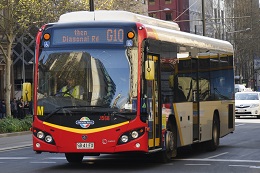09 August 2019
 A direct bus route from Modbury and Paradise to Flinders University, avoiding the CBD, would benefit thousands of Adelaide commuters, new UniSA research has found.
A direct bus route from Modbury and Paradise to Flinders University, avoiding the CBD, would benefit thousands of Adelaide commuters, new UniSA research has found.
Traffic engineer and UniSA PhD candidate Mona Mosallanejad has also recommended a direct Modbury to North Adelaide bus route after analysing bus travel patterns based on smart card data.
Mosallanejad’s data shows that Adelaide’s radial public transport system adds to the CBD traffic congestion in many cases, with most routes linked to the city.
Her research reveals that most bus trips in metropolitan Adelaide originate from suburbs around Paradise, Modbury, and Klemzig, although the Hills townships of Mt Barker is also popular with commuters.
The high usage in the north eastern suburbs is attributed to the frequency, reliability and speed of the O’Bahn Busway service, in contrast to many other bus routes which are slower and less reliable – a factor often attributed to low public transport usage in Adelaide.
Mosallanejad has used smart card data to develop a matrix (algorithm) which accurately estimates the origin and destination of bus users, considering short side trips and CBD transfers linking to new destinations.
“Adelaide bus users swipe their card when they board a public transport service but not when disembarking. One of the issues with estimating the destination is that it can be difficult to distinguish whether people are transferring to another bus or mode of public transport, or whether their journey is complete.”
The algorithm she has developed can determine a user’s destination and demand for public transport. It has a 98 per cent accuracy rate and is less time consuming and cheaper than traditional surveys which have often been used in the past to determine public transport usage.
Adelaide has one of the worst usage rates per head of population for a public transport system in the world, SA Transport Minister Stephan Knoll conceded in an article with InDaily earlier this year.
The poor uptake is attributed to several factors, including inadequate cross suburban routes, relatively cheap car parking in the CBD, an historical dependence on cars, lack of bus services outside peak hour and poor integration with train and tram services.
“If the Government want people to use public transport, they need to make it cheaper in peak hour and make the services more frequent from 6pm onwards. In most cases, there are only hourly services after that time,” she says.
It is hoped that her findings will help the State Government plan a more efficient public transport network for Adelaide going forward.
Additional notes
Mona Mosallanejad is a qualified civil engineer and a PhD candidate in the School of Natural and Built Environments at the University of South Australia. She has 12 years’ experience in the sector and works full-time for Aurecon, a global engineering consultancy. Her PhD supervisor is Sekhar Somenahalli.
The smart card data was obtained from the SA Department of Planning, Transport and Infrastructure.
For a copy of her paper, “Origin-Destination Estimation of Bus Users by Smart Card Data”, please contact mona.mosallanejad@mymail.unisa.edu.au
Media contact: Candy Gibson office +61 8 8302 0961 mobile: +61 434 605 142
email: candy.gibson@unisa.edu.au
Lead researcher: Mona Mosallanejad mobile: 0449 230 448 email: mona.mosallanejad@mymail.unisa.edu.au
…………………………………………………………………………………………………………………………




